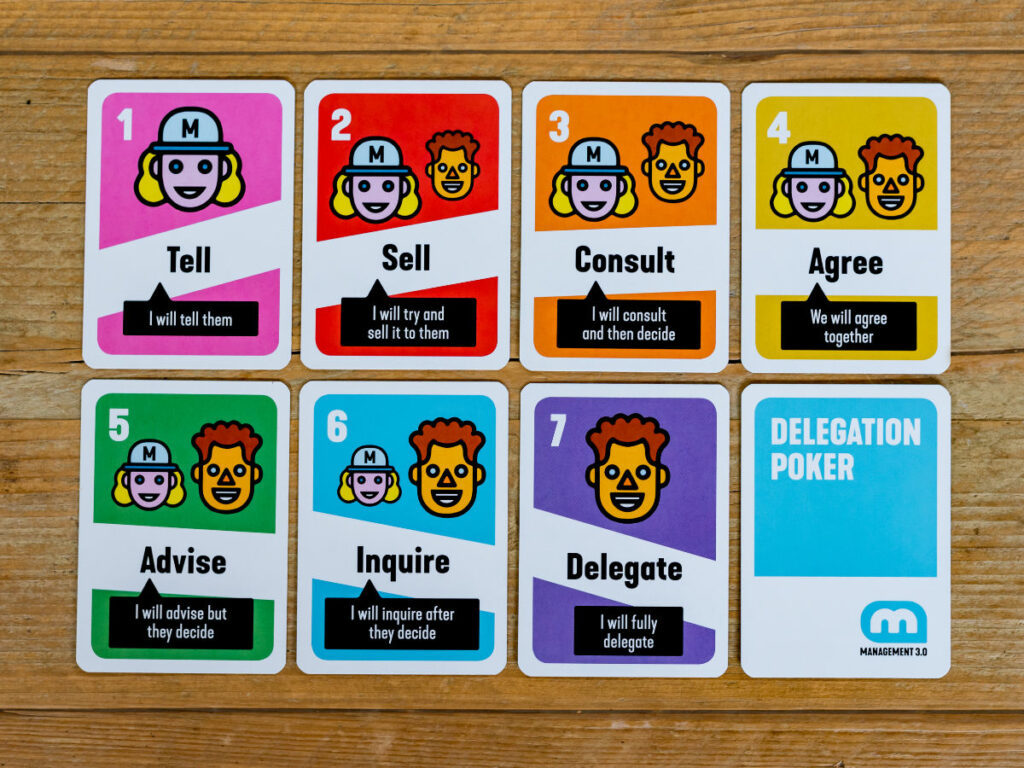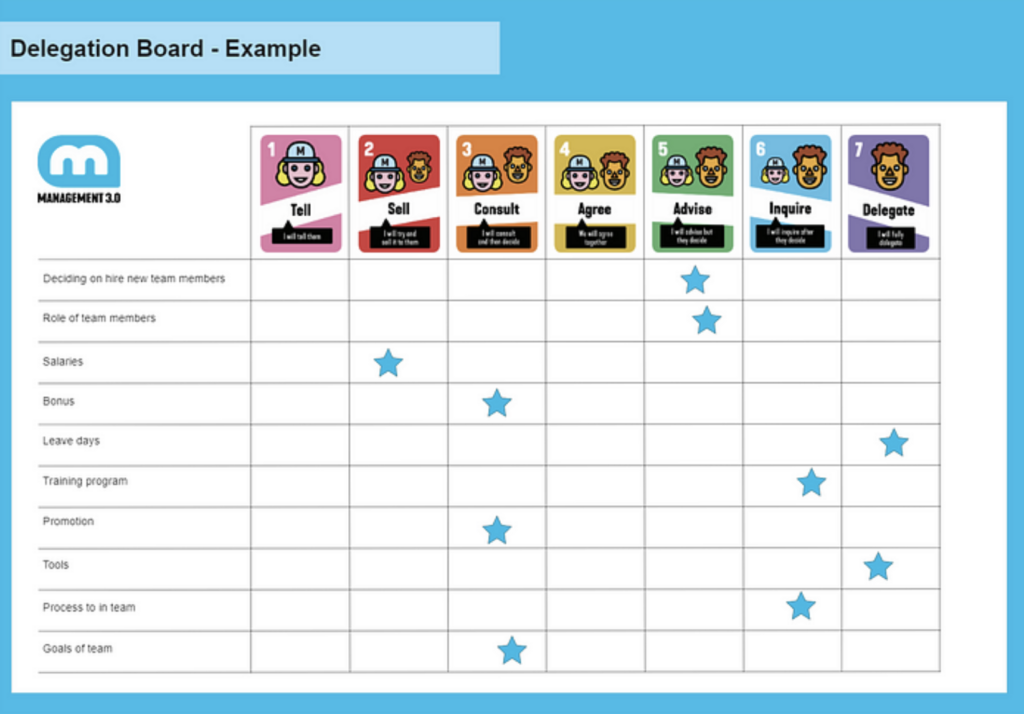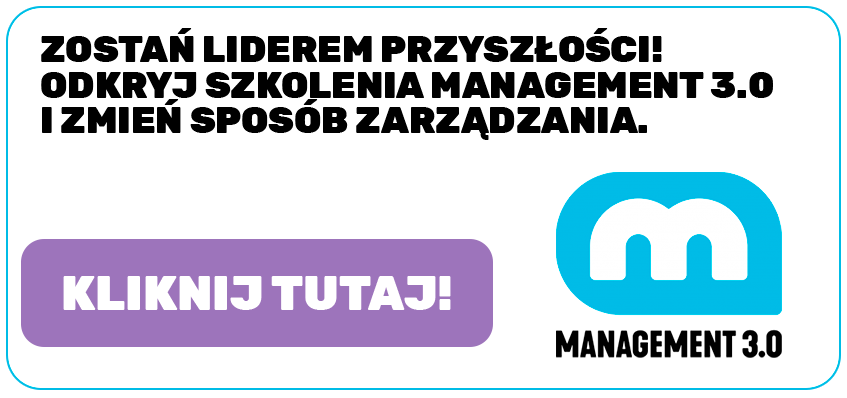Management 3.0 is a management concept that revolutionizes the traditional approach to working and managing teams. Management 3.0 offers many tools and practices that help you manage teams and organizations. One of them is Delegation Poker.
Why is delegating not easy?
Delegating is a key skill in today's business world. It means not only delegating tasks, but also giving team members responsibility and authority to make decisions and taking responsibility for their own work.
With successful delegation, you can increase work efficiency, boost team morale, and achieve overall improvement in performance by decentralizing decision-making. Nevertheless, many managers struggle with delegation, fearing loss of control, lack of trust or reduced quality of work. In such a situation, it is worth remembering that delegation is not binary. There are shades of gray between a dictatorial manager and an anarchist manager. Managers can delegate responsibility to teams in a controlled and gradual manner. The art of management is about finding the right balance.
On the other hand, if as a manager you want to delegate as much as possible (to reduce bureaucracy and give up power), do it gradually. If you take this delegation too far, the self-organization of teams can lead to undesirable and costly consequences, perhaps even chaos.
The extent to which you can delegate depends on many factors: the maturity of the team, its competences, the type of work performed, as well as the possible impact of a given decision on the organization.
What is Delegation Poker?
Delegation Poker it is a tool that helps teams and leaders understand and establish expected levels of autonomy and responsibility. It is a card game designed to facilitate discussions and negotiations regarding delegation within a team or organization. The game uses decks of cards, each representing one of seven levels of delegation, ranging from "Tell" (the lowest level of delegation) to "Delegate" (the highest level of delegation) - see below:

Why are there seven levels of delegation?
Delegation Poker was created by Jurgen Appelo as an extension Paul Hersey and Ken Blanchard's Situational Leadership model. In the Hersey-Blanchard model there are 4 levels of delegation: Tell, Sell, Participate, Delegate. According to Appelo, this model is very useful, but unfortunately it assumes a one-sided view of delegation - from the superior to the subordinate. In Management 3.0 we need a model that is wider and more symmetrical. We need a model that allows us to delegate work back and forth and helps clarify responsibilities on both sides, while supporting a safe environment for everyone involved. This is what Delegation Poker created by Appelo is like: 7 levels of delegation are a symmetrical model. It works in both directions: Level 2 (Sell) is similar to Level 6 (Ask) when viewed from the opposite perspective. And level 3, asking for input, is the reverse of level 5, which is about offering input.
How to use Delegation Poker?
We do not use the seven levels of delegation to decide on individual or single tasks. We use them in key decision-making areas, e.g. deciding on what technology to use, what framework to work in (Kanban, Scrum, etc.), and hiring new people. Here are some examples:
- The CEO has set the "Mergers and Acquisitions" decision area at delegation level 1, so he simply informs (tells) all employees by e-mail about the acquisition of another company.
- The Project Manager has set the "Project Management Method" decision-making area to delegation level 2, so he convinces (sells) team members to the idea of introducing an agile project management framework.
- The consultant has agreed on his client's "Key Technologies" decision area at level 5, so he advises (consult) the client on which technologies to use, but leaves the final decision to the client.
- The writer sets the “Printing and Binding” decision area at level 7 and fully delegates this topic to his professional printer.
The above examples are the result of using the Delegation Poker tool. But how can you start using Delegation Poker and avoid making mistakes? Here is a step-by-step description of the method:
- Deal of Cards: The person running the game (usually the team leader, manager, Scrum Master or Product Owner) hands out Delegation Poker cards to the team members. Each member receives his own deck of cards).
- Scenario Discussion: The team discusses the specific scenario or decision-making area that should be delegated.
- Card Voting: Team members use ballots to vote on their preferred level of delegation. They do it the same way as in Planning Poker - without showing the cards first, throwing them at the leader's signal.
- Negotiation: If there are differences in perception about the level of delegation, team members clarify their points of view. Like again Planning Poker, where we want to understand where the differences come from, what was the way of thinking, what was behind the decision to choose a given card.
- Determining the Level of Delegation: At the end of the discussion, all participants select a card representing their preferred level of delegation in the given case.
What is Delegation Board?
During one session, the team can establish the level of delegation for one decision area/scenario or for several. If the team is discussing and agreeing on delegation levels for several areas, they can describe the outcome of their findings on the Delegation Board (Delegation Board), which, for example, might look like this:

The Delegation Board can be a physical or electronic board. In the rows of this table we enter key decision-making areas that someone delegates to other people. In the columns, the table shows seven levels of delegation. For each key decision-making area, the board is labeled in one of seven columns, clearly communicating to everyone how far authority is delegated in that area.
The most important aspect of the Delegation Board is that it is "living". This means that once written, it should be reviewed and discussed, and over time the levels of delegation should move towards greater team autonomy.
Why use Delegation Poker?
Delegation Poker brings many benefits to both leaders and teams:
- Clarity: The game helps eliminate confusion about the level of delegation in specific tasks or projects.
- Increased Trust: Game participants have the opportunity to express their preferences and expectations, which contributes to building trust between team members and the leader.
- Team Development: Delegation Poker promotes independence and responsibility among team members, which can accelerate their professional development.
- Transparency: The game makes understanding the level of delegation more transparent, making it easier to make decisions and act on clear guidelines.
Summary
Delegation Poker is a valuable management tool that helps teams and leaders develop a clear understanding and trust in delegating tasks and decisions. Introducing this game into management practice can contribute to increasing team efficiency, improving communication and strengthening the culture of trust in the organization. Read about other Management 3.0 Pracites and tools.
Delegation Poker is also available in a remote work version as a template in Miro.






